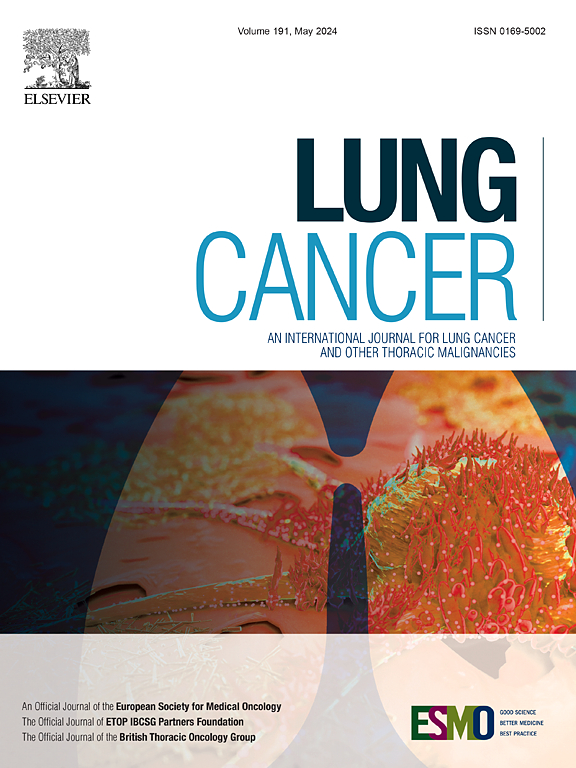KRAS G12C-associated immunotherapy benefit in NSCLC is substantially mediated by tobacco-induced tumor mutation burden, not allele-specific effects
IF 4.4
2区 医学
Q1 ONCOLOGY
引用次数: 0
Abstract
Background
KRAS G12C mutations in non-small cell lung cancer (NSCLC) have been associated with improved immune-checkpoint inhibition (ICI) outcomes. However, it remains unclear whether this benefit reflects allele-intrinsic biology or shared dependence on tobacco-induced mutagenesis and elevated tumor mutation burden (TMB).
Methods
We analyzed 9,230 lung adenocarcinoma (LUAD) tumors to assess the mutational context and oncogenic potential of KRAS G12 variants. For each variant, we estimated cancer effect sizes, and assessed associations with tobacco-related mutational signature SBS4 exposure and TMB. We applied regression models to evaluate the linkage between SBS4 exposure, TMB, and ICI outcomes.
Results
KRAS G12C and G12D mutations exhibited comparable oncogenic effect sizes. However, G12C mutations were significantly enriched in tumors with higher tobacco-associated SBS4 exposure and higher TMB. SBS4 exposure and TMB were highly correlated. Models of ICI outcomes as functions of TMB as a consequence of SBS4 exposure recapitulated observed clinical trends: hazard ratios decreased and response rates increased as observed.
Conclusions
The improved ICI response observed in KRAS G12C-mutant tumors is more likely driven by tobacco-induced hypermutation and its immunogenic consequences than by G12C-specific biological properties. When available, smoking history and TMB remain more cogent biomarkers for ICI stratification than KRAS G12C-variant NSCLC.
KRAS g12c相关免疫治疗在非小细胞肺癌中的益处主要是由烟草诱导的肿瘤突变负荷介导的,而不是等位基因特异性效应。
背景:KRAS G12C突变在非小细胞肺癌(NSCLC)中与改善免疫检查点抑制(ICI)结果相关。然而,尚不清楚这种益处是否反映了等位基因内在生物学或共同依赖于烟草诱导的诱变和升高的肿瘤突变负担(TMB)。方法:我们分析了9230例肺腺癌(LUAD)肿瘤,以评估KRAS G12变异的突变背景和致癌潜力。对于每种变异,我们估计了癌症效应大小,并评估了与烟草相关的突变特征SBS4暴露和TMB之间的关联。我们应用回归模型来评估SBS4暴露、TMB和ICI结果之间的联系。结果:KRAS G12C和G12D突变表现出相当的致癌效应大小。然而,G12C突变在烟草相关的SBS4暴露量较高和TMB较高的肿瘤中显著富集。SBS4暴露与TMB高度相关。由于SBS4暴露,ICI结果作为TMB功能的模型概括了观察到的临床趋势:观察到的风险比降低,反应率增加。结论:在KRAS g12c突变肿瘤中观察到的改善的ICI应答更可能是由烟草诱导的高突变及其免疫原性后果驱动的,而不是由g12c特异性生物学特性驱动的。在可用的情况下,吸烟史和TMB仍然是ICI分层比KRAS g12c变异型NSCLC更有说服力的生物标志物。
本文章由计算机程序翻译,如有差异,请以英文原文为准。
求助全文
约1分钟内获得全文
求助全文
来源期刊

Lung Cancer
医学-呼吸系统
CiteScore
9.40
自引率
3.80%
发文量
407
审稿时长
25 days
期刊介绍:
Lung Cancer is an international publication covering the clinical, translational and basic science of malignancies of the lung and chest region.Original research articles, early reports, review articles, editorials and correspondence covering the prevention, epidemiology and etiology, basic biology, pathology, clinical assessment, surgery, chemotherapy, radiotherapy, combined treatment modalities, other treatment modalities and outcomes of lung cancer are welcome.
 求助内容:
求助内容: 应助结果提醒方式:
应助结果提醒方式:


